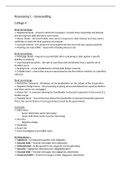Samenvatting
Samenvatting Financiering 1
- Vak
- Financiering 1
- Instelling
- Nyenrode Business Universiteit (Nyenrode)
Deze samenvatting betreft enkel de aantekeningen van het boek Principles of Corporate Finance, niet de volledige stof van het vak Financiering. Het boek is in het Engels, maar in de samenvatting zijn Nederlandse delen verwerkt.
[Meer zien]






